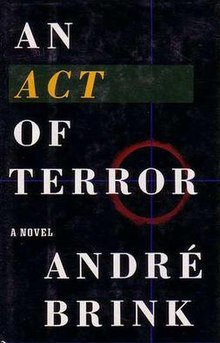An Act of Terror
This article's lead section may be too short to adequately summarize the key points. (November 2015) |
 First edition | |
| Author | Andre Brink |
|---|---|
| Language | English |
| Genre | Thriller |
| Publisher | Summit Books |
Publication date | 1991 |
| Publication place | United States |
| Media type | Print (Hardback) |
| Pages | 834 pp |
| ISBN | 0-671-74858-0 |
| OCLC | 24543771 |
| 823 20 | |
| LC Class | PR9369.3.B7 A65 1992 |
An Act of Terror is a novel by Andre Brink, first published in 1991.
Plot summary
The novel deals with the lead-up to, execution and consequences of, a bungled assassination attempt whose target is the unnamed State President of South Africa. The story follows the development of Thomas Landman, an Afrikaner who, bit by bit, is indoctrinated in, and comes to whole-heartedly believe, the ethos of black freedom-fighters. Abandoning his family's staid and repressive values for those of the blacks, he embarks on a course which ultimately leads to him becoming South Africa's most wanted terrorist. The story culminates in an escape from South Africa which leaves Landman badly mutilated and his lover dead. Throughout, one is exposed to the hypocrisy and self-delusion that were the necessary supports of the Apartheid regime.
Analysis
At times this book has touches of Wilbur Smith about it. It is mammoth in scope, and involves several long treks across the South African countryside. It is brimming with a wide and colourful set of characters. In Smithian fashion, the lead male protagonist finds capable female companions who embroider the story for a while, and then get killed. This creates the impression that development of the feelings that might surround a long-term relationship seem to be difficult for the author to handle. At other times the book has obvious literary leanings, with classical and historical references, close attention to words and their usage, and an innovative structure.
Two characteristics of the structure of the novel are striking. The narrative constantly switches between first and third person. The third-person narrative continues more or less throughout the book. The first-person narrative is made up of short sections contributed by practically every character in the story. There are therefore multiple voices, and multiple points of view. However, the most unusual aspect of the book is that it includes a thirteen-generation history of the fictitious Landman family. This describes the family's move to South Africa in the 17th century, and the events and people that filled the lives of each subsequent generation. At the same time it allows for an expose of the political shaping of South Africa, and presents a context for the events of the main story. This appendix is itself almost book-sized, extending for close to 150 pages. A comparatively long glossary of Afrikaans, Xhosa and other terms completes the book.
